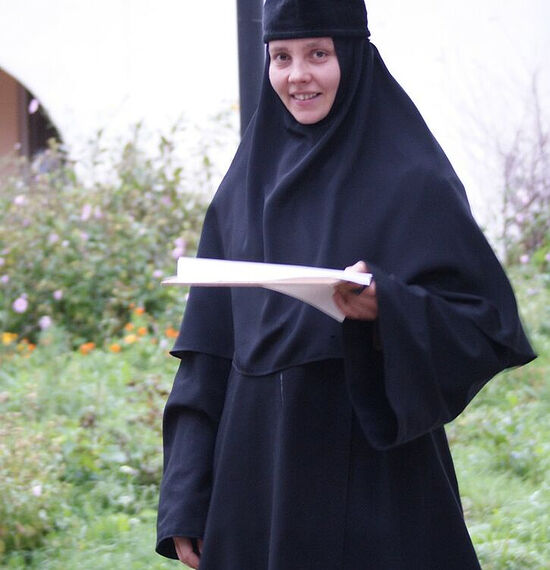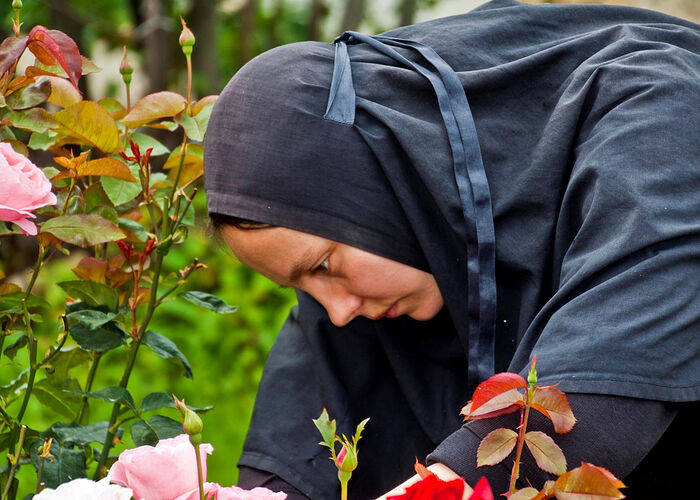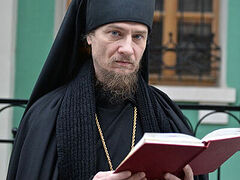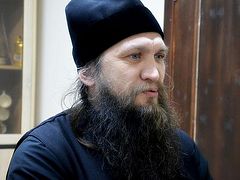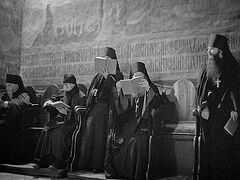 Sisters of the Kazan-St. Tryphon Hermitage. Mother Seraphim is second from the left.
Sisters of the Kazan-St. Tryphon Hermitage. Mother Seraphim is second from the left.
I met Mother Seraphima, then the twenty-three-year-old novice Anastasia, doing obediences at the Kazan-St. Tryphon Hermitage twenty years ago, in 2002. Nastya and I were weeding the monastery garden together and started talking—it was very joyful to talk with her and even just to be silent. She was a pure, bright person, very young, but zealous, having already tasted the sweetness of prayer, having experienced the truths spoken by the Prophet and King David: How sweet are Thy words unto my taste! yea, sweeter than honey to my mouth! (Ps. 118:103), and The LORD is nigh unto all them that call upon Him, to all that call upon Him in truth (Ps. 144:18). People often come to God as adults, after numerous sorrows and trials and severe illnesses. Nastya, dexterously weeding the carrots next to me, came to God as a little girl—by the fervent prayers of her grandmother. Here are her stories:
“There are bones—the meat will grow on them!”
I came to the monastery in 2001 and have been laboring here for more than twenty years already. I think my relatives were praying for me, especially my grandmother Feodosia, or Baba Fenya as we knew her in the family.
I was born in 1979, very weak, at seven months. My fingers were like little stubs. My father asked his mother, Baba Fenya:
“Will she survive?”
And she responded:
“There are bones—the meat will grow on them!”
I lived in the same room as Baba Fenya as a child, and it was constantly filled with the Word of God: Baba read the Gospel and Psalter every day and fasted according to the Church rule.
My Baba Fenya
My grandmother was born in the early twentieth century, in 1907, in the family of Praskovya and Fedor Kopotilov. My great-grandmother and great-grandfather lived in Siberia, in a village of the Tobolsk Governorate (the Tyumen Governorate since 1918). All the Kopotilovs were deeply religious. They had a large farm, with land and cattle. They prayed and labored, and the Lord sent them all things needful.
When it came time for Baba Fenya to go to school, the terrible First World War broke out. Times turned tough, and she only managed to go to school for two days, and then she had to go to work, to help her mother, because she was the eldest child in the family. There were three others besides her, each smaller than the other. She later learned to read and write a little herself.
Fedor Kopotilov, the father of the family, died in the civil war when my grandmother was just eleven, leaving my great-grandmother a widow with four children in arms. Her two sons and two daughters grew up hardworking and deeply believing, and they managed to keep the farm going without their father. Their homestead flourished through their labors.
In the 1930s, their prosperity came to an end: The Kopotilovs, like other affluent peasants, had their land, cattle, and all their property taken away.
Baba later recalled that there were only three alcoholics in their village, and the rest led a sober lifestyle. Drunkenness brought these three to complete impoverishment, and their wives and children had to turn to fellow villagers for help and alms. When collectivization began in the 1930s, it was these three who dispossessed the entire village.
Baba Fenya was a young girl when her entire family—she, her mother, her sister Yulia, and her two brothers—was left without a home, without farm animals or a way to earn money—basically, without anything. Then Praskovya and her children went to the Urals, where they settled in the working town of Lysva in the Perm Region.
Her sister Yulia got a job at a metallurgical plant, and her brothers served in the army, then left for World War II. The older brother Ivan went missing, and the younger brother Matthew died in a German concentration camp.
Great-grandma Praskovya lived out her days with her daughter Yulia, who never married, remaining a maiden. They always had many icons. Great-grandma lived to be 99, did embroidery without glasses into old age, and died in 1979, when I was just one month old.
My Baptism
Baba Fenya was my grandmother on my father’s side.
My relatives on my mother’s side were also repressed. Her grandfather, Yakim Cheremiskin, was exiled from Kirov Province to the north of the Perm Region with his entire family. It was only when he died that his family was allowed to return home.
My parents went to a Soviet school, were raised as atheists, and when they got older, they didn’t go to church. They didn’t baptize me, but I had Baba Fenya. When I turned four, my grandmother asked her children to gather all her unbaptized grandchildren: me, my brother, and my cousins.
She invited a priest, and we were all baptized at home. Batiushka’s name was Alexander Peredernin. He was in shiny yellow vestments, and as I remember, all glowing.
After the Baptism, Baba Fenya took my brother and me to Communion nearly every Sunday. Although my parents weren’t church-goers then, they didn’t forbid her to take us to church.
How I bowed at Christmas
This happened to me about a year later, when I was five: Christmas came, and Baba took us to church. I was in a white dress. They put us children up front before the solea. I was making bows throughout the entire service. My aunt said:
“Nastya, don’t bow so often.”
But that didn’t stop me, and I continued zealously bowing.
When we went up to kiss the cross, the priest praised me:
“Good job! You prayed so well!”
He put his stole on my head and said a prayer.
My childhood temptation
I became a believer thanks to my grandmother and her guidance. I never had any doubts in my heart about the existence of God.
However, I was tempted once. In third grade, a classmate yelled at me for believing in God, saying He didn’t exist.
Her words affected me like poison, creeping into my child’s soul, lurking there, and I decided I wouldn’t pray anymore from that day on. And indeed, in the morning, I didn’t pray as usual. But in the evening, when I lost something very important, I got down on my knees and started fervently entreating the Lord to help me find what I had lost. And suddenly I caught myself thinking that I was praying again. I realized then that I couldn’t not believe in God.
Wonderful people in my life
I’ve met some wonderful people in my lifetime: Archpriest Alexander Peredernin (the future abbot Varlaam of Belogorsk Monastery), Fr. Vladimir Vudinov of the Joy of All Who Sorrow Convent in Nizhny Talig, Igumen Savvaty (Rudakov), the spiritual father of our monastery, the abbess of our monastery—Mother Ksenia (Oschepkova), and many others. I’ll tell you about them too.
Fr. Varlaam (Peredernin)
I’d like to say a few words about the priest who baptized me. He had an amazing life. The village boy Alexander Peredernin, born in 1928, finished four grades at school and a factory apprenticeship and worked twenty-seven years at the Lysva metallurgical plant’s rolling mill. It was very hard work.
He raised ten children with his wife. His two sons, Vladimir (†October 14, 2021) and Alexander, are archpriests, his daughter Natalia a priest’s wife, and his twin daughters Anastasia and Paraskeva are nuns. There are also nuns among his adult granddaughters.
After being fired from the factory, Alexander Ilyich worked as a guard at All Saints Church on Miteinaya Hill (Verkhnechusovskie Gorodki), whose rector at that time was the elder Archpriest Nikolai Rogozin (1898–1981). Now our monastery, Kazan-St. Tryphon Hermitage, is at Miteinaya Hill, and the Elder rests with his relics in the crypt under the All Saints Church. That’s the connection.
 Elder Archpriest Nikolai Rogozin
Elder Archpriest Nikolai Rogozin
Later, Alexander Ilyich was ordained, served as a priest, and after becoming a widower, he was tonsured into monasticism at Holy Trinity-St. Sergius Lavra with the name Varlaam and was appointed rector of the ruined Belogorsk (White Mountain)-St. Nicholas Monastery in 1991, which he restored from the ruins.
One of the first sisters of our monastery, Mother Tamara (Povarnitsina), recalls how during the hard times of the formation of the young convent, Igumen Varlaam (Peredernin), abbot of the Belogorsk Monastery, visited us and brought the sisters a cow and a sheep.
Abbot Varlaam and the spiritual father of our monastery Igumen Savvaty
Our spiritual father, Igumen Savvaty (Rudakov), was tonsured on White Mountain, and it was Abbot Varlaam who tonsured him. This is how Fr. Savvaty talked about it:
I was tonsured on White Mountain in 1992—the first tonsure after the monastery began to revive. I knew that the brothers of this monastery were martyred during the years of the revolution. More than forty monks were shot, and the abbot, Archimandrite Varlaam (Konoplev), was thrown into the Kama River. It was an honor for me to be tonsured there…
Abbot Varlaam (Peredernin), a very revered priest among the people, was at one time an archpriest with many children, and then he was widowed, his children grew up, many of them became priests, monastics, and he himself, already old, older than sixty, was tonsured and served in a parish. Then Vladyka blessed him to restore the monastery on White Mountain. And he took this terribly heavy, almost unbearable cross upon himself as an obedience—the last cross in his life. It was his Golgotha.
When I went to Fr. Varlaam on White Mountain to be tonsured, it was in ruins: a broken-down three-story building where the wind blew through the empty corridors, a ruined cathedral… It was Great Lent. They made a temporary church out of the trapeza, because it was impossible to serve in the cathedral. The stove didn’t heat very well in this temporary church, and it was so cold that the Blood froze in the chalice. They had to serve in felt boots because it was so cold.
There were obstacles before my tonsure. Fr. Varlaam went somewhere and wasn’t able to return. There were some problems with the car, and when he finally returned, it was approaching midnight. So it was already nighttime when I was tonsured. Three names were chosen: St. Pitirim of Perm, St. Arsenios the Great, and St. Savvaty of Solovki. They wrote these names on three slips and put them in a box. We prayed. When I reached into the box, I heard an inner voice: “You’ll be Savvaty.” And indeed, I pulled out the slip with the name Savvaty.
During the tonsure you have to crawl, and the monastic brethren cover you with their mantias. But in this monastery being restored, there was no monastic brotherhood yet, and I crawled alone, for a long, long time, as it seemed to me… And when I had reached the feet of Abbot Varlaam in just a thin tonsure garment, I didn’t feel any cold.
A few people were singing on the kliros during my tonsure, and I heard a powerful monastic choir of male voices around me, as if the entire White Mountain brotherhood, once tortured and shot, was singing. I felt their presence with all my heart; I felt kinship with them; I heard their voices, and my soul froze, and I even looked around furtively, trying to see this invisible brotherhood. It was a miracle and a consolation…
 Igumen Savvaty (Rudakov) and our abbess Mother Ksenia (Oschepkova)
Igumen Savvaty (Rudakov) and our abbess Mother Ksenia (Oschepkova)

